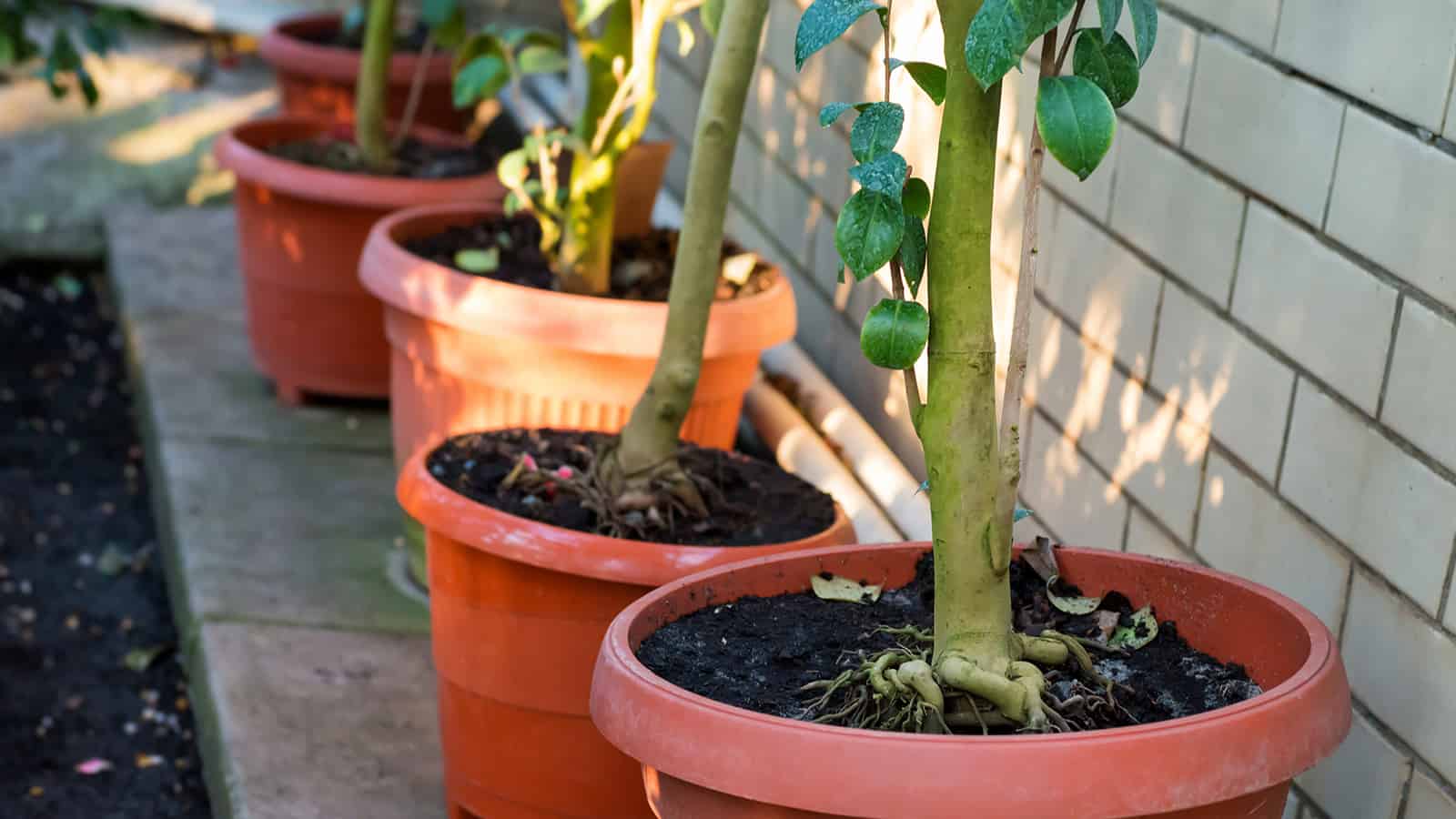While it’s easy to go out and buy fruit at the grocery store, it’s even better to grow fruit trees in pots at home. Growing fruit in planters can be life-changing, and you’ll love having the plants in your home, too. However, the task might seem overwhelming if you are unsure of where to start.
Experts say that adults should consume 1.5 to 2.5 cups of fruit each day. This amount seems like an easy feat, but it’s only easy if you have fruit on hand. When you grow fruit trees at home, you will always have easily-accessible snacks.
Once you’ve decided that you want to grow fruit trees in pots, you must figure out the best ones to plant. You’ll want to consider the climate in your location, accessibility to the sun, and other essential factors. Plus, you must know how to plant them if you want your fruit trees to produce food.
Focus on Self-Fertile Trees to Start if You Want to Grow Fruit Trees
Self-fertile trees don’t require another plant for pollination, whereas self-sterile options do. You might take plants indoors, depending on the season, when growing plants in pots. It would help if you considered that they might not have the other plants they need unless you plant those, too.
It’s best to start with self-fertile plants so that you don’t have to worry about it in the beginning. There are pros and cons to both self-fertile and self-sterile fruit trees, so research each type.
Ten Fruit Trees You Can Grow in Pots (and How to Plant Them)
1. Avocado Trees
Avocado trees are a good option for growing in pots because you can use the seed from the fruit you eat. You’ll use three or four toothpicks to suspend the pit with the pointy side down in a glass of water.
Cover only about one inch of the avocado pit in water, and put the cup in a warm place. Make sure to avoid direct sunlight until the roots appear. Once you have roots, you can plant your avocado tree in a pot, leaving half of the seed exposed.
Avocado trees thrive in moderate humidity, and you must water them two or three times each week. You might have to wait five to thirteen years for the tree to produce an avocado, but it’s well worth the wait.
2. Apple Trees
Before growing an apple tree, you’ll want to remember how big they get. If you keep the tree in a pot indoors, you’ll likely want to choose a dwarf size apple tree. The seed you plant might not be the same tree you receive, as apple trees are self-sterile and require another seed or plant to bear fruit.
You can start apple trees as seeds, placing them on a damp paper towel inside a resealable plastic bag. Put the bag in the refrigerator for 70 to 80 days, waiting until you see shoots coming from the seeds. After planting your tree, please place it in a sunny location and water it every ten to twelve days.
Apple trees can take eight to ten years to bear fruit, so be patient. Additionally, these fruit trees require colder weather for part of the year, so they likely won’t survive in tropical areas.
3. Cherry Trees
To grow cherry trees in pots, you’ll need to place dried cherry seeds in an airtight container in the refrigerator. Leave the seeds for ten weeks, and when the shoots are ready, plant them in the pot of your choice. You don’t need multiple varieties of seeds because cherries are self-fertile.
Cherry trees require lots of sunlight and circulation, so use sandy soil for proper drainage. Keep the soil moist, watering anytime it starts to feel dry. After seven to ten years, watch for the tree to produce cherries.
4. Tangerine Trees
When growing tangerines in a pot, you’ll want to keep them in a well-lit location but avoid direct sunlight. The plants grow to around three or four feet tall, so keep that in mind when you plant them.
Choose soil that drains well, and be sure not to over soak it. If possible, use seeds from fresh fruit for a better chance of growth. It can take four to seven years for a tangerine seed to grow flowers and produce fruit.
5. Currant Trees
Currant trees are self-fertile, so they can quickly grow in a planter. You can choose from many varieties and colors, making it the perfect fruit tree for your home. Start with a container of about ten gallons, and gradually increase the size each year.
When you water the tree, aim to pour about an inch of water each week over the root zone. Avoid giving it a little water each day because that only moistens the surface area. Your currant tree can produce fruit in one to three years, so you don’t have to wait as long as others.
6. Plum Trees
Plums are a great option when planting fruit in a pot, but obtaining the seed takes a little work. Put one pit from a plum on a sunny windowsill for a few days, then use a nutcracker to break the shell and get the seed from inside. Be careful not to damage the seed as you crack open the pit.
Place the seed inside a container of water to see which ones sink. The seeds that drop are good to plant because it indicates they’ll sprout when you plant them. Leave the sunken seeds in the water overnight before planting them.
When you’re ready to plant, you’ll want to fill a container two-thirds full of soil or compost. Add a little water, and plant the seeds inside before sealing the container.
Put your sealed container in the refrigerator until the seeds germinate and sprout. This process can take six to eight weeks, so be patient. Once grown, plant the seeds in the soil using a pot a few inches deeper than the roots.
A plum tree can produce fruit in three to five years with proper care, including watering, sunlight, and humidity. The fruit might not be the same variety as what you consumed, so don’t be surprised it’s different.
7. Lemon Trees
Lemons are easy to grow from seeds because you can place them directly in the soil. If some don’t sprout, plant at least five to ten seeds. If some don’t germinate, make sure you water them two to three times each week.
It’s best to obtain seeds from a fresh lemon and try to gather the largest ones you can find. Lemon trees require lots of sunlight, and it takes five to fifteen years to bear fruit.
8. Peach Trees
You can plant peaches after removing their seeds from the pits. Before planting peach seeds in a pot, you must wrap them in a damp paper towel and refrigerate them for eight weeks. After eight weeks, the seeds should have sprouted so that you can plant them in soil.
Peach trees require good drainage, or the root system can die. Plus, you must keep the soil moist without overwatering to prevent the tree from rotting. Peach trees need lots of sunlight, and it can take three to five years to produce fruit.
9. Blueberry Trees (Technically a shrub, not fruit trees)
Blueberry trees require cold temperatures, so this option might not work in a tropical climate. When you plant blueberry seeds, you must have at least one another variety because they are self-sterile plants. Blueberries are easy to grow, but you must keep some space between plants for the roots to grow.
10. Pear Trees
To grow pears in pots, you must place the seeds in a plastic bag with a wet paper towel. Put the bag in the refrigerator for sixty to ninety days until you see sprouts. After that, put the seeds in a glass of water for two days before planting them in the soil.
Pear trees thrive in well-drained soil and with at least six hours of sunlight. Water it at least once a week for best results, and remember that it’ll need more water depending on the amount of sun it receives. It can take three to ten years for a pear tree to produce fruit.
Growing From Seeds or Obtaining Roots to Start Growing Fruit Trees
While growing plants from seeds take a while to produce fruit, it’s a fun and easy way to get started. However, if you want plants that have fruit sooner, you can get plants by cutting roots from mature trees.
Final Thoughts on Fruit Trees You Can Grow in Pots (and How to Plant Them)
If you don’t have the space to grow fruit trees in your yard or prefer potted plants, these options can help. It’s fun to have fruit trees throughout your home or sitting on your patio, so start planting your trees as soon as possible.
Whether growing your trees from seed or using mature roots, it’ll be well worth the experience. Start with one or two trees at a time, and make it a point to try new ones as often as you can.

















 Community
Community

